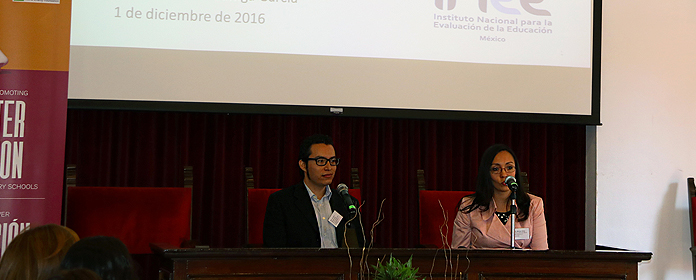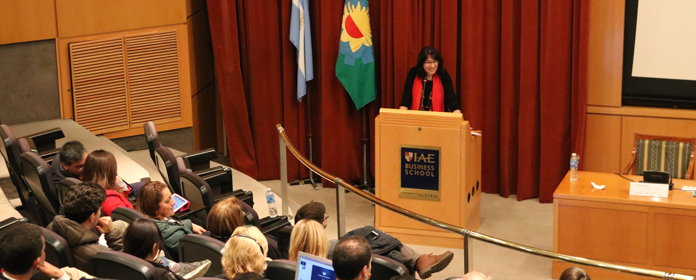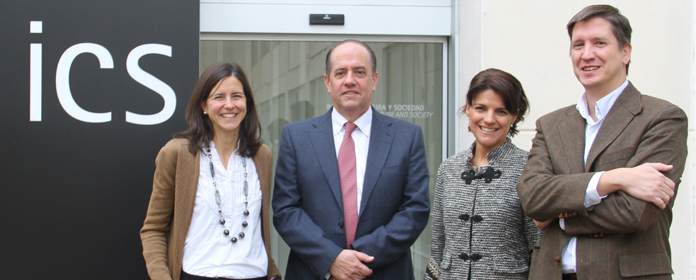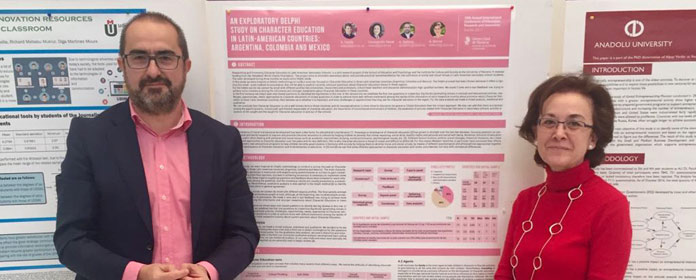"Character education combats inequality because it prepares people to face life’s problems"
Mariana Zúñiga, from the National Institute for the Evaluation of Education, participated in a University workshop held at the Panamerican University

Mariana Zúñiga, from the National Institute for the Evaluation of Education (Mexico), participated in a workshop organized by the University of Navarra (Spain) and held at the Panamerican University (Campus Mexico). She presented a paper entitled “Vision, legislation and educational practice in Mexico,” in which she reveals the National Plan for the Evaluation of Learning’s (Planea) progress in evaluating students in the sixth and ninth grades.
Zúñiga was one of 25 experts from Mexico, Colombia and Argentina who attended a workshop organized by the Researching and Promoting Character Education in Latin American Secondary Schools project, a joint initiative of the Institute for Culture and Society and the School of Education and Psychology at the University of Navarra. The project receives funding from the Templeton World Charity Foundation.
What importance does character education (or moral education) have in secondary education?
Character education or socio-emotional skills are important in and of themselves, and they are also necessary for maintaining a cordial and healthy environment. They are important not just for school and basic education, but also involve the acquisition of lessons for adult, family and work life. In short, they are fundamental for people’s development and well-being.
How can character education or socio-emotional skills help decrease inequalities among adolescents?
The acquisition of socio-emotional skills can possibly help to bridge achievement gaps between those who have the most and the dispossessed, but it is not the solution to all the inequality and inequity problems within the National Education System. Character education or socio-emotional skills indirectly impact the fight against inequality because they prepare people to cope with life's problems, whether economic or family, just to name a few.
These skills are now seen as especially important because they are considered essential for life and key parts of acquiring other lessons. In Mexico, the National Plan for Learning Assessment (Planea) not only contemplates measuring performance levels and the school context, but also is beginning to evaluate students’ socio-emotional skills.
What should we take into account when assessing socio-emotional skills and inequality?
When we talk about inequality, we are talking about the need to meet the diversity of conditions and needs of students, teachers and schools throughout the country. An important part of improving the distribution of resources is having relevant information that gives an account of the educational status of schools, which is why national learning evaluations are an essential tool.
In addition, character education or socio-emotional skills are closely linked to the right to learn and the quality of education. This right indicates that schools must conform to the specific conditions of their school population, that students should feel safe, respected, and accepted by the school and that what is taught should coincide with their interests and, above all, should be useful for life. If these conditions are not met, it is difficult for students to improve their socio-emotional skills.
What is the current state of Mexican schools in terms of inequality and achievement?
Inequalities in educational attainment are assessed through the size of gaps at different levels and between groups. Inequalities have been measured with high school students during the last ten years, during 2005, 2008 and 2012, in Spanish achievement levels using Educational Achievement Quality Testing (EXCALE). The results of the three evaluations show that tele-secondary schools, characterized by being located in rural areas and often lacking necessary infrastructure, present the largest gap with private schools.
Another way to analyze inequality in educational attainment is through the percentages of students that fall into four performance levels (N1, N2, N3, N4). These levels are cumulative, that is to say, students who achieve the learning goals of a certain level possess the ones from previous levels. For example, the primary results of Planea 2015 show that 80% of students in indigenous schools are at achievement level one, which is the lowest, while 13.3% of private school students are at that level. This indicates that the majority of students from indigenous schools will have serious difficulties throughout their school career. With these results, it is possible to give a general idea of future trends in students’ educational achievements.
What are the challenges in this part of education for fostering academic achievement?
The first challenge is the ability to truthfully and adequately measure character education and its components. Because it is a broad term with different definitions, delimiting the dimensions that compose it and conceptualizing it is a complex task.
The second challenge refers to making inferences about its impact on students’ achievement levels in different contexts. One does not start from zero; there is already some evidence of this— for example, the results from the Third Regional Comparative and Explanatory Study conducted by OREAL and UNESCO in 2015 show that the perception of violence in the vicinity of Mexican schools is negatively related to students’ performance level. This evidence suggests that the school environment and socio-emotional skills within a given school have a profound impact on achievement levels. However, we need to measure socio-emotional skills rather than violence to get more accurate data.
The third challenge involves undertaking a thorough analysis and using evaluation results. The information obtained by relating performance levels and socio-emotional skills would greatly assist in understanding the dimensions of the education system’s possible inequalities and inequities, which would also help answer questions such as: Are there any vulnerable groups that, because of their socioeconomic conditions, present lower levels of socio-emotional skills and does this affect their school performance levels? Would responding to this help build a general picture of students' abilities in this country? In all likelihood, the most difficult task involves using this information to develop strategies and interventions for improving education.




